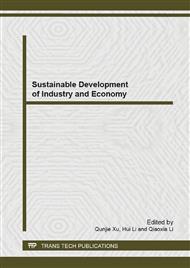p.581
p.593
p.598
p.603
p.612
p.623
p.627
p.634
p.640
Operating Efficiency Analysis of Energy Industries in Taiwan
Abstract:
The energy business has played an important role in an economic growth of Taiwan because the market share is in the high value that can make a significant contribution towards regional and local employment. However, Taiwan is lack of energy resources, making the country highly relies on an import for more than 98 percent of its all energy. At present, a top priority of the countrys policy is to develop clean, sustainable, independent, and efficient energy in order to eliminate the vulnerability from external disruption. Therefore, this research aims to assess the operating efficiency and to analyze factors affecting the efficiency scores of the registered energy companies in the Taiwan Stock Exchange (TWSE) recorded during 2003-2012. The super-efficiency data envelopment analysis (SE-DEA) was initially applied to reveal the additional efficiency scores, followed by the Tobit regression model used to analyze what factors determine the efficiency scores. The empirical results showed that seven DMUs performed efficiently, ranking from 7.29 to 1.02. The company with the best operating performance was Taiwan Cogeneration Corporation (TCC), while the Great Taipei Gas Corporation (GTG) revealed the worst efficiency score. Furthermore, the Tobit regression model explained that the higher number of the local employees, the greater the efficiency scores were. Besides, the lower number of the shareholders, the greater the efficiency scores were. As a result, the Taiwans government is supposed to encourage all energy companies to have a higher number of local employees and shareholders to increase their efficiency scores.
Info:
Periodical:
Pages:
612-620
Citation:
Online since:
December 2013
Authors:
Price:
Сopyright:
© 2014 Trans Tech Publications Ltd. All Rights Reserved
Share:
Citation:


